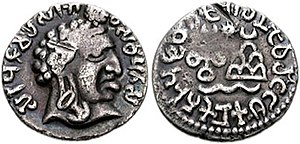වාශිෂ්ඨීපුත්ර පුලුමාවී
සාතවාහන රජ
වාශිෂ්ඨීපුත්ර පුලුමාවී (බ්රාහ්මී: 𑀯𑀸𑀲𑀺𑀣𑀺𑀧𑀼𑀢 𑀧𑀼𑀎𑀼𑀫𑀸𑀯𑀺, Vāsiṭhiputa Puḷumāvi, IAST: Vāsiṣṭhiputra Śrī Pulumāvi) වනාහි සාතවාහන රජකු වන අතර, ඔහු ගෞතමීපුත්ර සාතකර්ණීගේ පුත්රයායි.[5] වර්තමාන සංඛ්යාලේඛන අනුව ඔහුගේ රාජ්ය සමය ලෙස ක්රි.ව. 85-125 පිළිගැනේ.[6][7][8] එසේවුවද මින් පෙර එය විවිධ අයුරින් ක්රි.ව. 110–138[9] හෝ 130–159 ලෙස විශ්වාස කෙරිණි.[10] මොහු වාශිෂ්ඨීපුත්ර ශ්රී පුලුමාවී ලෙස ද හඳුන්වයි. දෙවන සියවසේ රචකයකු වූ ටොලමි, පුලුමාවී ව හඳුන්වා ඇත්තේ චස්තානා නම් බටහිර ක්ෂත්රපයන්ගේ සමකාලීනයකු ලෙස සිරිටොලමේයස් යන නාමයෙනි.[11]
| වාශිෂ්ඨීපුත්ර පුලුමාවී | |
|---|---|
  ශ්රී වාශිෂ්ඨීපුත්ර පුලුමාවීගේ ප්රාකෘත සහ ද්රවිඩ ද්වීභාෂා කාසිය සහ අභිමුඛ ප්රාකෘත පාඨයෙහි පිටපතක්. අභිමුඛ: රජුගේ රුව. ප්රාකෘත පාඨය බ්රාහ්මී අක්ෂරවලින් (12 වේලාවට අදාළ ස්ථානයේ සිට): 𑀭𑀜𑁄 𑀯𑀸𑀲𑀺𑀣𑀺𑀧𑀼𑀢𑀲 𑀲𑀺𑀭𑀺 𑀧𑀼𑀎𑀼𑀫𑀸𑀯𑀺𑀲 රාණෝ වාසිඨිපුතස සිරි-පුළුමාවිස "වාශිෂ්ඨීගේ පුත්ර, ශ්රී පුලුමාවී රජ" ප්රතිමුඛ: උජ්ජයින් සහ බොකුටු කඳු සංකේත. එම පාඨය ද්රවිඩ බසින් (තෙලිඟු සහ දෙමළ බසට ආසන්න වූ),[1] and the Dravidian script,[1] බ්රාහ්මී අක්ෂරවලින්[2] (12 වේලාවේ පිහිටුමට අදාළ ස්ථානයෙන් අරඹන්න): 𑀅𑀭𑀳𑀡𑀓𑀼 𑀯𑀸𑀳𑀺𑀣𑀺 𑀫𑀸𑀓𑀡𑀓𑀼 𑀢𑀺𑀭𑀼 𑀧𑀼𑀮𑀼𑀫𑀸𑀯𑀺𑀓𑀼 Arahaṇaku Vāhitti Mākaṇaku Tiru Pulumāviku[3] හෙවත්: අරචනකු වාචිට්ටි මකාණකු තිරු පුලුමාවිකු[4] "Of King Tiru Pulumavi, son of Vasishthi"[2] | |
| සාතවාහන රජ | |
| රාජ්ය සමය | ක්රි.ව. 1වන සහ 2වන සියවස |
| පූර්වප්රාප්තිකයා | ගෞතමීපුත්ර සාතකර්ණී |
| අනුප්රාප්තිකයා | වාශිෂ්ඨීපුත්ර සාතකර්ණී |
| රාජවංශය | සාතවාහන |
| පියා | ගෞතමීපුත්ර සාතකර්ණී |
ආශ්රේය්යන්
සංස්කරණය- ^ a b Sircar, D. C. (2008). Studies in Indian Coins (ඉංග්රීසි බසින්). Motilal Banarsidass Publishe. p. 113. ISBN 9788120829732.
- ^ a b "The Sātavāhana issues are uniscriptural, Brahmi but bilingual, Prākrit and Telugu." in Epigraphia Andhrica (ඉංග්රීසි බසින්). 1975. p. x.
- ^ Epigraphia Āndhrica (ඉංග්රීසි බසින්). Government of Andhra Pradesh. 1969. p. XV.
- ^ Nākacāmi, Irāmaccantiran̲; Nagaswamy, R. (1981). Tamil Coins: A Study (ඉංග්රීසි බසින්). Institute of Epigraphy, Tamilnadu State Department of Archaeology. p. 132.
- ^ Singh, Upinder (2008). A history of ancient and early medieval India : from the Stone Age to the 12th century. New Delhi: Pearson Education. p. 381. ISBN 9788131711200. සම්ප්රවේශය 11 April 2016.
- ^ Bhandare, Shailendra, (1999). Historical Analysis of the Satavahana Era: A study of Coins, University of Mumbai, pp. 168-178.
- ^ Shimada, Akira, (2012). Early Buddhist Architecture in Context: The Great Stupa at Amaravati (ca 300 BCE - 300 CE), Brill, p. 52.
- ^ von Hinuber, Oskar, (2016). "Buddhist Texts and Buddhist Images: New Evidence from Kanaganahalli (Karnataka/India)", ARIRIAB Vol. XIX (March 2016), p. 15.
- ^ Carla M. Sinopoli (2001). "On the edge of empire: form and substance in the Satavahana dynasty". In Susan E. Alcock (ed.). Empires: Perspectives from Archaeology and History. Cambridge University Press. p. 166-168. ISBN 9780521770200.
- ^ Susan L. Huntington (1 January 1984). The "Pāla-Sena" Schools of Sculpture. Brill Archive. p. 175. ISBN 90-04-06856-2.
- ^ "According to Ptolemy, Siriptolemaios (Sri Pulumayi), son of Gautamiputra Satakarni, continued to reign at Paithan (Pratisthana), while Ozene (Ujjain) fell into the hands of Tiasthenes (Chastana)." Alain Danielou, A Brief History of India (Inner Traditions, 2003), mentioned here
- ^ Alcock, Susan E.; Alcock, John H. D'Arms Collegiate Professor of Classical Archaeology and Classics and Arthur F. Thurnau Professor Susan E.; D'Altroy, Terence N.; Morrison, Kathleen D.; Sinopoli, Carla M. (2001). Empires: Perspectives from Archaeology and History (ඉංග්රීසි බසින්). Cambridge University Press. p. 172. ISBN 9780521770200.
| පූර්වප්රාප්තිකයා ගෞතමීපුත්ර සාතකර්ණී |
සාතවාහන පාලක ක්රි.ව. 2වන සියවස |
අනුප්රාප්තික වාශිෂ්ඨීපුත්ර සාතකර්ණී |